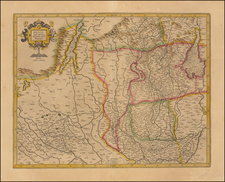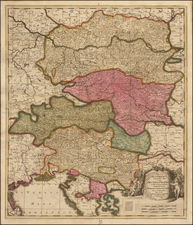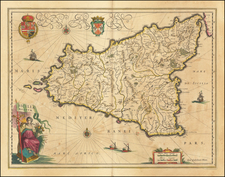Fine two-sheet map of Italy, Sicily, Sardinia and Corsica, published by Coronelli.
The map is embellished by several elaborate cartouches, coats of arms and other decorative features and includes 2 tables showing the ancient and modern divisions of Italy.
Vincenzo Maria Coronelli was among the most important and influential map makers of the late 17th Century. After starting his career in Venice, he was invited by Louis XIV to Paris to construct a monumental set of globes, which are among the most famous cartogrpaphic works of the 17th Century. During his time in Paris, he collaborated extensively with JB Nolin, which provided him with access to the best available French maps, at a time when France was asserting its pre-eminence in the field of map making. As a result of this access, Coronelli's maps are among the most accurate of their time, combining the best available geogrpaphical information with Coronelli's remarkable engraving style.
In the 14th and 15th centuries, northern-central Italy was divided into a number of warring city-states, the rest of the peninsula being occupied by the larger Papal States and the Kingdom of Sicily (referred to as Naples). Though many of these city-states were often formally subordinate to foreign rulers, the city-states generally managed to maintain de facto independence from the foreign sovereigns that had seized Italian lands following the collapse of the Western Roman Empire. War between the city-states was endemic, and primarily fought by armies of mercenaries drawn from around Europe, especially Germany and Switzerland. Decades of fighting eventually saw Florence, Milan and Venice emerge as the dominant players. Each agreed to the Peace of Lodi in 1454, which saw relative calm brought to the region for the first time in centuries. This peace would hold for the next forty years.
The 17th century was a tumultuous period in Italian history, marked by deep political and social changes. These included heightened Spanish influence over the Peninsula as well as increased power of the Pope and the Roman Catholic Church at the peak of the Counter Reformation, the Catholic reaction against the Protestant Reformation. Following the Italian Wars, ignited by the rivalry between France and Spain, the city-states gradually lost their independence and came under foreign domination, first under Spain and then Austria. Spain's involvement in the Thirty Years' War, financed in part by taxes on its Italian possessions, heavily drained Italian commerce and agriculture. As Spain declined, it dragged its Italian domains down with it, spreading conflicts and revolts. In the 18th century, as a result of the War of Spanish Succession, Austria replaced Spain as the dominant foreign power, while the House of Savoy emerged as a regional power expanding to Piedmont and Sardinia.
In 1629-1631, a new outburst of plague claimed about 14% of Italy's population, and the plague of 1656 killed up to 43% of the population of the Kingdom of Naples.
The Renaissance, a period of vigorous revival of the arts and culture, originated in Italy thanks to a number of factors: the great wealth accumulated by merchant cities, the patronage of its dominant families like the Medici of Florence, and the migration of Greek scholars and texts to Italy following the Conquest of Constantinople at the hands of the Ottoman Turks. The Italian Renaissance peaked in the mid-16th century as foreign invasions plunged the region into the turmoil of the Italian Wars. The ideas and ideals of the Renaissance soon spread into Northern Europe, France, England and much of Europe. In the meantime, the discovery of the Americas, the new routes to Asia discovered by the Portuguese and the rise of the Ottoman Empire, all factors which eroded the traditional Italian dominance in trade with the East, caused a long economic decline in the peninsula. In spite of Italy having given birth to some great explorers, and effectively the renaissance. The discovery of the New World undermined the importance of Venice and other Italian ports as commercial hubs by shifting Europe's center of gravity westward towards the Atlantic.
Vincenzo Maria Coronelli (1650-1718) was one of the most influential Italian mapmakers and was known especially for his globes and atlases. The son of a tailor, Vincenzo was apprenticed to a xylographer (a wood block engraver) at a young age. At fifteen he became a novice in a Franciscan monastery. At sixteen he published his first book, the first of 140 publications he would write in his lifetime. The order recognized his intellectual ability and saw him educated in Venice and Rome. He earned a doctorate in theology, but also studied astronomy. By the late 1670s, he was working on geography and was commissioned to create a set of globes for the Duke of Parma. These globes were five feet in diameter. The Parma globes led to Coronelli being named theologian to the Duke and receiving a bigger commission, this one from Louis XIV of France. Coronelli moved to Paris for two years to construct the King’s huge globes, which are 12.5 feet in diameter and weigh 2 tons.
The globes for the French King led to a craze for Coronelli’s work and he traveled Europe making globes for the ultra-elite. By 1705, he had returned to Venice. There, he founded the first geographical society, the Accademia Cosmografica degli Argonauti and was named Cosmographer of the Republic of Venice. He died in 1718.










![Johnson's Italy [Large inset of Malta]](https://storage.googleapis.com/raremaps/img/small/99472.jpg)
![Tabula Nova Italiae [New Map of Italy]](https://storage.googleapis.com/raremaps/img/small/103202.jpg)
![(Turin) Nuova pianta della citta di Torino [New Map of the City of Turin]](https://storage.googleapis.com/raremaps/img/small/86314.jpg)

